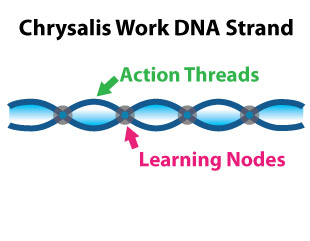Our social systems (governments, corporations, etc.) have been designed to deliver their primary products and services – their A-work. More often than not, this design resulted in narrow/myopic definition of success, rigid structures and no capacity to self-evolve. Our moving into an Age of Conscious Evolution, an age when our social systems continuously and consciously self-evolve in ways that multiply their contribution to the well-being of all life, requires that our social systems develop their capacity for generative B & C-work. This is no small challenge. It requires a special transition architecture – a bridge of sorts, and the systemic design and construction of three strong spans. It is important to approach the architectural design and execution of systemic-capacity building initiatives (C-work) with the same level of deliberation and commitment as we do for our physical structures.
The 3-Span Bridge Model helps distinguish the challenge of building systemic capacity from the simpler challenge of developing individual capabilities.
A capacity-building initiative is only as strong as its weakest span.
We can easily visualize the range and distribution of expertise required to design and construct a new office building. Hundreds of people may be involved. Expertise in dozens of specialized technologies and crafts are required in order to plan, design and construct a building that satisfies the diverse needs of the many people who will ultimately be involved. We know that the expertise of an experienced architect will be essential to the success of such a project.
Systemic-capacity building initiatives can have much more at stake than an office building project. And yet, it has become common for organizations and other social systems to undertake capacity-building initiatives without having developed adequate B & C-work expertise throughout their leadership.
C-work expertise is critical to discovering generative (highly leveraged, life-giving) approaches to systemic capacity-building. C-work requires architectural skills, the ability to understand and design for all of the various kinds of developmental work required. Generative approaches to C-work usually involve developing a high level of B- and C-work expertise in key players throughout the system. For example in organizations, one proven approach involves recruiting/selecting line organization leaders with developmental aptitudes and placing them on, say, two-year full-time assignments as B & C-work practitioners. This has the multiplying benefit of developing high potential players into transformational leaders through hands-on expericnce.
Systemic-capacity building work usually requires special infrastructure to be successful. Just as scaffolding and forms are essential to the construction of complex physical structures, so systemic-capacity building needs special support and protection, especially during its formative stages.
Perhaps the most elegantly effective infrastructure for capacity-building initiatives is an organizing fabric woven from “action-learning strands.” These highly flexible forms can be easily adapted to the various levels and stages of any initiative. Action-learning strands consist of an on-going cycle from “learning nodes” with learning in the foreground and doing is in the background, to “action threads” with doing in the foreground and learning in the background.
The “Community of Practice” model is a common example of an infrastructure that takes the form of an “action-learning strand.” In a community of practice, practitioners interested in developing their particular area of expertise meet together periodically to share their stories and to seek help on specific challenges they’ve encountered.
 This organic infrastructure can become as natural and important to system sustainability as breathing is to physical sustainability. Action-learning strands may be created as a form of scaffolding to support a particular one-time change initiative. They may also be woven throughout a social system as the fabric that holds its developmental fabric in place.
This organic infrastructure can become as natural and important to system sustainability as breathing is to physical sustainability. Action-learning strands may be created as a form of scaffolding to support a particular one-time change initiative. They may also be woven throughout a social system as the fabric that holds its developmental fabric in place.
The resemblance of this graphic depiction to DNA is nicely synchronous. When woven into the fabric of a social system these strands help shape, develop and sustain a culture of on-going, ever-improving system learning and change.
First we shape our structures, then our structures shape us
Leaders can speak of high purpose, compelling visions and inspiring values. However, if appropriate infrastructure isn’t evolved to address the capacity building challenges implicit in their visions, they’re just blowing smoke. Conversely, if infrastructure is constructed that is both robust and congruent with the special needs of this special work, a powerful message is sent—and magic is unleashed.
Just as designing and building a physical structure requires an investment of time, attention and money, so it is with building new system capacities or managing system change. While this is obviously true in the early stages of exploring, planning and designing such initiatives, it is equally true during the startup, implementation and stabilization stages.
Bill Veltrop: I’ve been engaged in, witnessed and studied organizational learning and change initiatives for well over 30 years. There’s nothing more painful than to witness the incredible direct and hidden costs occurred when these initiatives aren’t adequately resourced. It can be as serious as taking off on a transatlantic flight without adequate fuel.
It is always best to stack the deck for success when birthing and nurturing a new culture and new system capacities. You can always reduce resources when they are no longer needed. You only have one opportunity to do things for the first time.